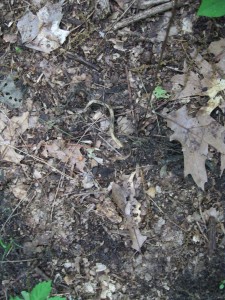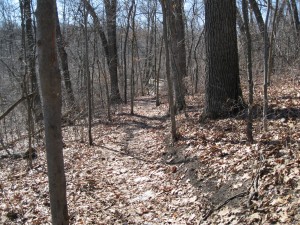Early this April, I saw a tall skinny shrub without leaves but with catkins. It reminded me that early last fall I had come across a clump of similar skinny trunks that bore pointed, toothed leaves. The leaves were more or less like leaves of several groups of woody plants–birches, elms, hornbeams, and conceivably a few others. I had been puzzled by the plant and hadn’t identified it for sure but had narrowed it down to a handful of possibilities. One of the possibilities had been American hazelnut (Corylus americanus). The books I was using commented that catkins are produced in the fall but don’t open to produce pollen until the following spring. These catkins weren’t quite open yet, but seeing them there tilted me toward thinking that the plants must be hazelnuts.
The plant was in a handy place to observe, so I was able to keep track of it over the next couple of weeks as the catkins lengthened and then opened, shedding pollen.
The pistillate flowers of hazelnut are tiny buds, but recognizable by the thin red styles–ready for pollen–poking out the end. The styles are easily seen with a lens. The hazelnuts when they ripen in the fall look like the European filbert of commerce, but smaller. They’re also similar in taste.
The first time I saw hazelnuts I was probably six or seven years old. My parents took me along when they went hazelnut picking one day in the fall. The spot wasn’t far from where we lived east of Murphysboro, Illinois, probably a quarter of a mile down the county road toward Route 13. I enjoyed eating the nuts at the time but never became a big filbert fan.
I’ve seen hazelnut fruits in the wild in Michigan a few times, but never in these woods. Two possibilities occur to me. The first is that the woods are too shady, especially with the increasing abundance of red maple, for the shrubs to accumulate enough energy to produce fruits. The second is that the nuts are so attractive to the squirrels, woodpeckers, and jays that they have always been eaten (or stored) before I chance to wander by in the fall.

Hazelnut in oak woods--former oak openings--in Oshtemo Township. Photo 21 June 2011 by Richard Brewer
Now that I’m attuned to the look of hazel even without catkins or hazelnuts, I’ve seen several clumps in both drier and wetter parts of the oak woods. Most of the clumps are between knee high and waist high, only a few head high or taller.
Since I’ve been in Michigan, I’ve associated hazelnut with the edges of prairies, and I think that’s apt. But now I’ve begun to understand (1) its remarkably wide ecological amplitude and (2) how widespread it must have been in almost every permutation of prairie and savanna that existed in pre-settlement southwest Michigan.
One indication of hazelnut’s wide habitat occurrence can be drawn from John T. Curtis’s The Vegetation of Wisconsin. This excellent book has a species list in the back (after the Literature Cited and before the index), that gives the plant community where the species most frequently occurs and also given the number of plant communities in which Curtis found the species in his studies. The community in which the species was found most often–the modal community–is presumably the most characteristic community; the number of communities from which the species is recorded is a measure of ecological amplitude of the species.
The book recognizes 34 plant communities. American hazelnut was reported most frequently from dry forest, but it occurred in 20 other communities, or 62 per cent in all.
I didn’t go through the species list line by line, but I did check on some species that I think of as occurring in a wide variety of situations. There were a few species in the 15-18 community range and at least one species that occurred in the same number of communities as hazelnut–21. This was Cornus racemosa, gray dogwood. Vitis riparia, river-bank grape, had a 22. There were only two species clearly ahead of the hazelnut, dogwood, and grape. These were Va. creeper, Parthenocissus quinquefolia, 1n 25 communities and poison ivy, Rhus radicans, in 26 (76%). It may not be accidental that all five of these species are woody and have animal-dispersed seeds.
Hazelnut’s broad distribution more or less centered on dry forest fits well with the conception of oak openings that Kim Chapman and I expressed in an article (“Prairie and Savanna in Southern Lower Michigan: History, Classification, Ecology”) in the January 2008 Michigan Botanist. We see oak openings in the pre-settlement landscape as a diverse community, the composition of which varied in space–different in low and high spots, north slopes and southwest slopes, sandy sites and gravelly sites. But it also varied in time at any given point based on the latest disturbance (fire, tornado, insect infestation) and how recent it was, but also on the historic frequency of disturbance. A north-facing slope running down to a pond in a small kettle might have included a set of plants much like mesic forest. A gentle loamy slope after a few years of near-annual fires might have been covered with dry-mesic prairie.
This is oak openings in the sense of Michigan pioneer botanist Ruth Hoppin’s description (quoted on pages 7-8 of Chapman and Brewer). In this view, most of the prairie and savanna types are just different faces of one big community type. Mesic prairie and bur oak plain, I would say, are different and so, of course, is mesic forest.
Hazelnut seems to have the life history traits to be a near-perfect fit to the oak openings habitat as it was. Hazelnut can get around readily by the nuts being carried, and often buried, by mammals and birds. Over short distances, it spreads readily by rhizomes. It tolerates a wide range of light intensities though it tends to decline in deep shade. It tolerates fire, but only up to a point. Most of its rhizomes and roots are in the upper six inches of soil. Light fires kill the above-ground parts of the plant but stimulate vigorous sprouting from the rhizomes. Fires hot enough to consume the litter often kill the underground parts. Hence, hazelnut might be at least temporarily eliminated by fire from certain habitats where hot, litter-consuming fires occurred.
I suspect most of the hazelnut plants I’ve been finding in the Oshtemo oak woods are just hanging on, waiting for the fires the openings used to have, the fires that would stimulate sprouting and open the canopy to enough sunlight to yield a good crop of nuts. One more reason why few of the hazel bushes grow tall may be the high populations of deer these days. Hazel is a favored browse plant of deer, so high populations may keep it pretty well clipped.














